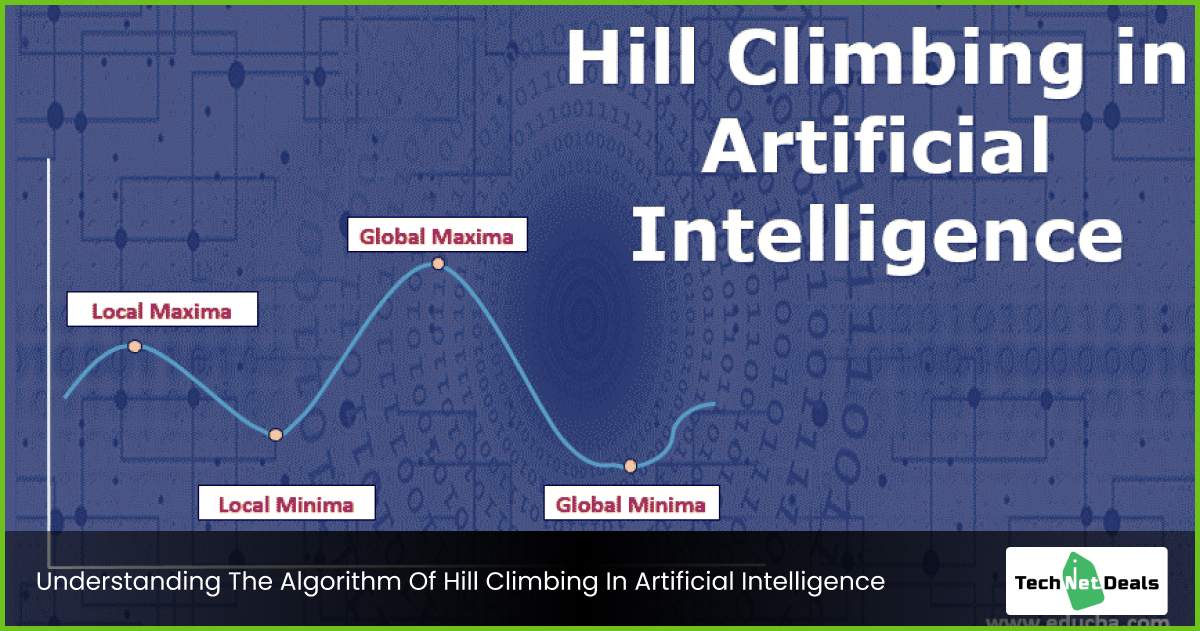
AI is a blessing. When you are tired of doing repeated work, AI tools are there to help you. But only monotonous and loop repeated jobs are possible with AI? No, there is a little difference with regular machine-level language coding. You can perform repeated work. But as AI is much more intelligent. Hence it can find the best solution for the problem. This is the fascinating part of artificial intelligence. Take the example of an algorithm of hill climbing in artificial intelligence.
Let’s look at the bookish definition of algorithm hill climbing in artificial intelligence.
What Is A Hill-climbing Algorithm In Artificial Intelligence?

The hill-climbing algorithm is a continuously moving local search algo. The target of this algorithm is to find the best solutions. So the algorithm moves continuously; until it reaches the peak of a mountain. And there is no other alternative value around.
Hill climbing in artificial intelligence is an optimization technique. Two nodes are there. One represents the state, and another one represents the value. The single current state is calculated to apply the hill-climbing algorithm in artificial intelligence. Until the algorithm is not going to finds the best solution, it continuously moves and climbs higher, towards the mountain peak.
3 Elements Of Hill Climbing Algorithm
Like every optimization algorithm, hill-climbing also has some specific features.
Here are three different features and elements of the hill-climbing algorithm:
Backtracking Is Not Possible: The algorithm graph has two nodes. But backtracking is not possible. This is because the algorithm does not remember the previous state.
Best Test Result: Hill climbing is a variant and generates the best rest result.
Optimize Till Find The Best Solution: Hill climbing in artificial intelligence is testing the feedback and moving on to the search space. So the analytical ability is always there.
Diagram For Hill Climbing Algorithm

Hill climbing in artificial intelligence is represented by the state-space graphical representations.
For the graphical representations, you only have to pick two axes.
- X-axis state-space
- Y-axis objective function/cost function
Global Maximum Value: Global maximum value is the best possible case in which state-space has the highest objective function.
Current state: It is a landscape diagram representing the agent’s present state.
Flat Maximum: This is a landscape space where all the neighboring states of current states have identical values.
Local Maximum State: It is a better state than the neighboring state. But there is multiple higher states around.
Shoulder: It is a flat region that has an uphill mountain edge.
3 Different Kinds Of Hill Climbing Algorithm

The Hill climbing in artificial intelligence is finding the best possible solution and minimizing the effort of the users. You do not have to rely on random testing.
Here are three different types of hill-climbing algorithms which you can apply based on your requirements:
1. Simple Hill Climbing Algorithm:
The operation is pretty simple, as its name suggests. This algo is only evaluated at the neighboring node state at a time. Then select the optimized value of the current cost. If it finds a better one than its current state, it moves. Else it remains in the same position.
- This process is easy.
- Often the generated value is not correct as the value is less optimal.
Implementation of Simple Hill Climbing:
Here is the step-by-step guide for simple hill climbing in artificial intelligence:
Step 1: Evaluate the starting state and set the goal state.
Step 2: Run the Loop until finding a better solution. The loop will run until there are no new operators left.
Step 3: Select the current state operator.
Step 4: Check for any new state: If it reaches the goal state, return to success and finish the process. Else it will run again until it finds a better state.
Step 5: Exit.
2. Steepest-Ascent Hill-Climbing Algorithm
The steepest-Ascent algorithm functions are similar to simple hill climbing in artificial intelligence. This algorithm examines all the neighboring nodes of the present state and selects the goal nearest node. This algorithm takes more time to reach the goal.
- This algorithm’s run time is high.
- The value is relatively more optimal than simple hill-climbing as it checks multiple nodes simultaneously.
Implementation of Steepest-Ascent hill-climbing Algorithm:
Here is a step-by-step guide to implementing the Steepest-Ascent hill climbing in artificial intelligence:
Step 1: Evaluate the initial start state,
Step 2: Run the Loop until finding a solution for the current state.
Step3: For each operator, check the current state. Then apply to the new operator and generate a brand new state.
Step4: If multiple nodes checking is possible, it is quiet if it reaches the goal state.
Step5: Exit.
3. Stochastic Hill Climbing In Artificial Intelligence:
Stochastic hill climbing does not examine all the neighbouring nodes before its moving. The functions are a little bit scattered. This algorithm randomly selects any node and turns it into a current state. After that, it proceeds to the next state and checks it.
- Functions take more time.
- You will find more ups and downs in this hill climbing in artificial intelligence.
Implementation Of Stochastic Hill-Climbing Algorithm:
Here is a step-by-step guide to implementing Stochastic hill climbing in artificial intelligence:
Step 1: Evaluate the initial start state value.
Step 2: Run the Loop until finding a solution for the current state.
Step3: For individual operators, check the current state. Then apply to the new operator and generate a brand new state.
Step4: Function is checking random nodes, so repetitions are not required. And after checking a single node, it proceeds to the next one. If goal reaches then loop stops.
Step5: Exit.
Is Hill Climbing In Artificial Intelligence An Error-Free Process?

A hill-climbing algorithm never makes a move towards a lower value. Mean only when the random nodes are checking through, then only the optimal result is possible unless it will stick on the maximum local value.
Here are some problems which are present at hill climbing in artificial intelligence:
- Backtracking is not possible here. But with the backtracking, you can also explore the other paths and search places.
- If the landscape plateau is a flat surface, then neighbour states contain the exact current state value. In that case, the algorithm does not find any direction to move along.
- A ridge problem is an error in finding the maximum local value. The area is higher, but it has a slope. With a single move, the algorithm can not reach up. Unless your nodes can not move and explore different paths, this problem will always be there.
Frequently Asked Questions (FAQ):
Is hill-climbing a complete Process?
Hill climbing is a part of numerical analysis. This is an algorithm that provides a random solution to a problem as it is using mathematical optimization. It provides a more accurate solution depending on the present state. But if the current state and plateau structure change, it will affect the result of the Hill climbing.
Where is the hill climbing algorithm frequently used?
It does not have any backtracking. As a result, it does not maintain any search trees. So when you are having hard problems and a bulk amount of nodes to check. Then you must apply this process.
What is the significant advantage of using hill-climbing search?
Hill climbing is useful for many areas. Such as automatic programming, circuit designing, portfolio management, and vehicle routing. You can apply this algorithm whenever you have to find the best solutions based on the best objective functions.
Conclusion
With the hill climbing in artificial intelligence, you can find the closest optimal solution. It is more effective for local search. So if you want to find the solutions from a bulk amount of data, then you must apply this algorithm and find the best solution.
Read Also:






